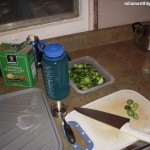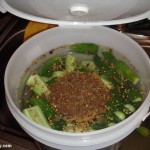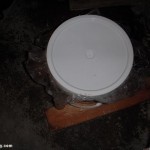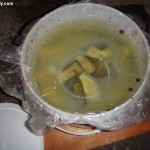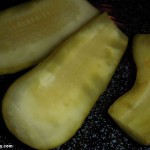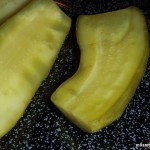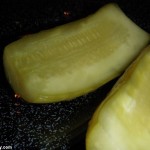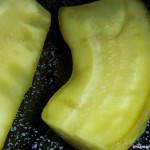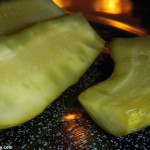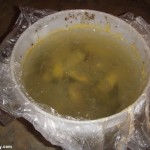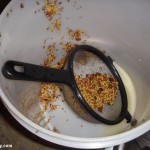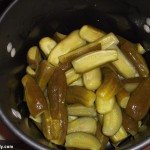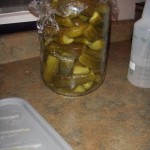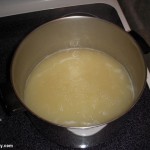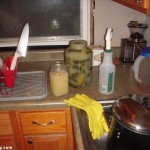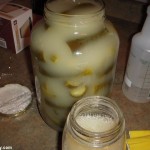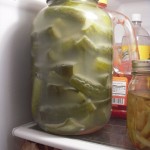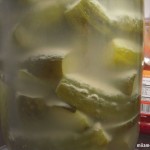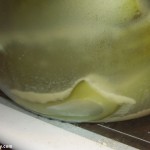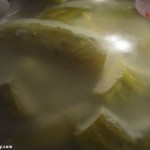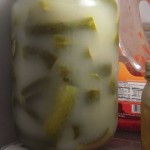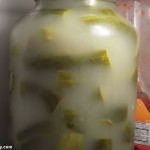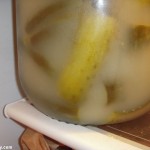At first I thought that I was going to process all the pickles that I bought at the downtown Farmer’s Market into v2 & v3 pickles. But while processing the ~7lbs of cucumbers for v2 & v3, I thought that I would go a different route and try to make some brine fermented pickles. Years and years ago back in Michigan I tried to make fermented pickles, and the experiment was an utter failure. So now that I’ve got a little bit more canning and homebrewing experience under my belt, I thought that I would give fermented pickles another try. Before this fermented experiment begun, I stopped by the library to pick up a copy of The Joy of Pickling by Linda Ziedrich(not the revised edition), to try and get a base recipe down, as well as some tips and tricks.
So using the Mustard Dill Pickle recipe from the book as a starting point, here is the recipe that I came up with (using what I had on hand):
Brine ratios:
- 1 quart of cold water
- 3 TB of canning/pickling salt
I ended up needing three quarts of brine to cover the submerged cucumbers, and 1 quart of brine for the plastic seal.
Remaining ingredients:
- ~8 lbs of cucumbers, both ends removed, and cut in half length wise
- 3 TB pickling spice mix
- 2 TB Dill Seed
The process couldn’t be more easier then cleaning (and sanitizing) a 2 gallon food grade bucket and adding all the cucumbers and spices, topping it off with the brine mixture. I then sanitized a glass dinner plate, and used it to weight down the cucumbers. Finally I sanitized a small sheet of plastic and placed it on the surface of the brine, filling it with a quart of brine. I then placed the bucket down in a cool/dark spot in the basement and let mother nature do her magic (making sure to check the brine about every day for any scum or mold formation.) To be on the safe side, I swapped out the glass salad plate for a new sanitized plate once a week, just to help prevent any mold formation. (see side notes below on mold/scum.)
The “Joy of Pickling” recipe listed that the pickles should be done in after about two to three weeks of fermenting, and they should look olive colored at that point. I ended up letting them ferment for 3 1/2 weeks (25 days), and I think that I was pushing my luck with those extra 3 to 4 days past 3 weeks, since it started to look like the brine on top of the plastic sheet was starting to get an “infection.” So having caught the pickles just in time, I then tossed out the “sealing brine” that was infected. I then separated the pickles from the brine. Giving the pickling two quick soaks (30 secs to 1 min) in cold water, draining out the rinsing liquid to get the pickles as dry as possible. While the rinsed pickles are draining in the sink, I double strained (first a coarse strainer and then a coffee filter) the pickle brine. At this point I brought the pickle brine to a boil and boiled the brine for 7 mins, skimming off any scum that forms on the surface, then cooled it to room temperature. I used an ice bath in the sink, which takes about 5-10 mins. While the brine is cooling in the sink, pack the drained pickles into into a one gallon jar that has been cleaned and sanitized, topping it off with the cooled brine. You can then store the pickles in the fridge for about a year (or so the recipe says).
Side notes:
1) I tried one of the “pickles” after about 10 days in the brine. And it was close to being done, but it still needed about another week or two to finish fermenting. Since when you looked at the pickle, it only looked about half way cured. (see pics below)
2) I really have to find a better weight other then a glass plate, like a weight lifting plate. Since a glass plate just isn’t heavy enough to keep stuff weighed down in the brine. I’ve been keeping my eye’s peeling for a good and cheap weight lifting plate, but I just haven’t found the right one yet.
3) In the original recipe it called for adding in a couple of stalks of celery, one sliced onion and 1/2 cup of horseradish to the fermentation crock. Next time I might have to actually follow the recipe and try out this combination.
4) Next year, I’m going to have to grow dill, even though I forgot to do it the last two years. But with all these pickles that I’m making, I think the end product would be better served with fresh dill compared to using dill seed.
5) I’d never seen this before, but the recipe called for using fresh grape leaves to line the bottom of the crock. As well as to layer the grape leaves with the pickles. At the time I started the fermentation, I didn’t have any fresh grape leaves on hand. It wasn’t until later on that I realized that my neighbor in the back had a couple of grape vines. Another thing for me to remember for next year.
6) The pickles have been sitting for about a week in the fridge, and I’ve noticed the strangest of phenomena. In that the particles (proteins?) suspended in the brine that makes it cloudy. Separates out from solution and settles on the pickles, making the brine less opaque. Personally I haven’t seen this happen before, so if someone can provide some insight into why this happens, it would be appreciated.
